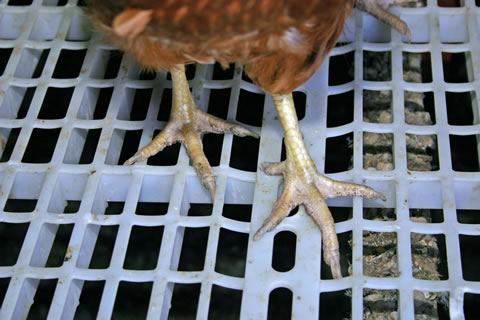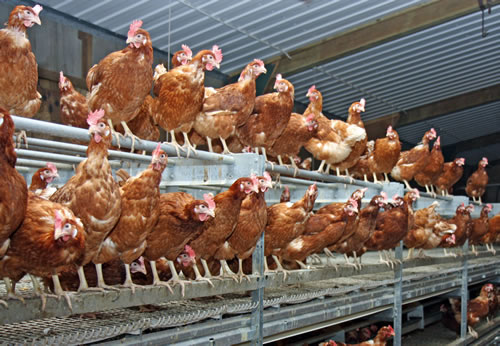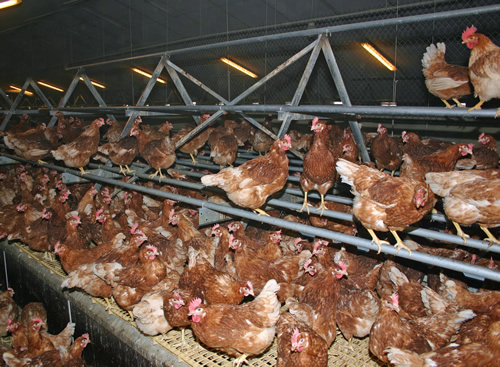
Free range egg producers in England and Wales could be forced to spend money on converting their hen houses if the European Commission manages to force the Westminster Government to change the way it interprets EU rules on perches.
Fears of such a prospect have been raised after Andrea Gavinelli, the head of Unit D5 - Animal Welfare in the Health and Consumers Directorate General of the Commission, produced a document in which he outlined the way rules on the welfare of laying hens should be enforced by member states. Mr Gavinelli says categorically in this document that slatted floors cannot be classed as perches – a view which contradicts the way in which the EU regulations have been implemented in England and Wales.
Defra is considering Mr Gavinelli’s interpretation of the rules, but the NFU says the department should stick to its own interpretation of the regulations. "Defra should defend its position," said Rob Newbery, the NFU’s chief poultry adviser. "It should stick to its previous interpretation because farmers have made decisions based on that interpretation. If it was to change now there would be cost implications for free range egg producers."
BFREPA vice chairman Jeff Vergerson said there would not only be cost but also welfare implications for free range layer units. "Despite the cost of converting traditional slats and litter units to provide 15cm per bird of aerial perching, I would not object to this if I genuinely felt it would improve hen welfare," he said. "But to install all these perches above the pit would create a forest of dangerous obstructions for the hens to collide with every time they fly up in one of their frequent mini-panics. I have spent a good proportion of my time trying to de-clutter sheds only to have the EU telling me I’m wrong," he said.

"There is existing and ongoing research telling us that a high proportion of end of lay free range hens show evidence of old bone fractures at the processing stage. Adding all these perches would, in my view, only make the situation worse."
What complicates matters in the United Kingdom is that the regulations have been interpreted in two different ways. Whilst in England and Wales farmers have been advised that floor slats can be classed as perches, in Scotland egg producers have been told that only separate perches are permissible. The difference of interpretation has arisen because the issue comes under devolved powers operated by the Scottish Parliament.
EU officials have raised their concerns about the position in England and Wales for some time. Rob Newbery said it was an issue that was raised by EU inspectors every time they inspected free range systems in England and Wales. "It is no surprise that they are saying the system here needs to change. We have known for some time that there is some disparity between the Commission and Defra’s interpretations. It was not helpful that Scotland took a different view, but Defra should stick to the line it has held previously."
Andrea Gavinelli’s view is expressed in a document entitled ’Legal interpretation of Council Directive 1999/74/EC laying down minimum standards for the protection of laying hens.’ It was issued by the European Commission Health & Consumers Directorate General on April 13 this year in Andrea Gavinelli’s name, although the document does carry a disclaimer. It reads, "The views expressed may not in any circumstances be regarded as stating an official position of the European Commission."

The documents says there is a need for legal clarity because of "interpretation divergences as regard minimum requirements for enriched cages and alternative systems.
laid down in Council Directive 1999/74/EC." The document offers clarification on a number of clauses within the directive.
On the issue of slatted floors as perches, it says, "Part of slatted floor cannot constitute a perch under Directive 1999/74/EC since the floor is not elevated so as to adequately satisfy the behavioural needs of the animals. Perches can meet the needs of the animals only when they are elevated, as confirmed by the scientific assessment." In another section, the document says that birds should be able to put their claws below perches.
How Defra will react to this latest intervention from Andrea Gavinelli is as yet unclear. A spokesman for the department issued the Ranger with a short statement, which read simply, "We are considering our position following this latest interpretation by the Commission."
If Defra does decide to stand by its own interpretation of the rules, it seems that the Commission would have to be prepared to take the matter to court to enforce its view on the Westminster government. A note at the end of the Gavinelli document reads, "According to Article 19 of the Treaty on European Union, it remains the exclusive competence of the European Court of Justice to interpret EU law authoritatively."
If the way the rules are implemented in England and Wales changes, the effect on free range egg producers would depend on a producer’s individual circumstances. Paul Turley of Vencomatic said that multi-tier systems would comply with Andrea Gavinelli’s interpretation of the rules, but he said that a change of interpretation could prove more troublesome for producers with traditional units.
"Multi-tier is already covered. It has already got 15cms per bird built into it. That is because Freedom Food insisted on that in order to allow multi-tier into the Freedom Food standard. The perches are already in on Vencomatic multi-tier systems," said Paul.
He said the position with conventional units was more difficult. "It would depend a lot on what width of slat you had on each side of the nest, because the typical solution would be to put an A-frame type perch system in with a feeder running through it, so that you get three lines of perching per track of feeders. But that takes up a lot more space and if you have got a shorter slat and then you are trying to put A-frames between the feeders you won’t fit it all in. It gets very, very, very busy. Most people have already got provision for some perching because they will have perching on top of the nipple drinkers. There’s a bit there but not 15cms per bird."
Paul estimated that the cost of the A-frames needed for a conversion would amount to about £1.60 per bird, including perch pipe. The price would cover only delivery. Assembly would incur extra cost if the producer did not want to carry out the work himself. Paul said that having to convert would have implications not only on cost.
"There would be serious implications. You have got the cost of conversion. There is the question of whether or not you can convert with your existing layout. If you have got a six metre slat and four lines of feeder each side, by the time you have got these A-frame perches on you haven’t got much room at the inn. You won’t fit it in," said Paul, who said a producer may have to look to a new slat arrangement or find some other way of accommodating perches. "It’s not easy.
"Then there are the management and health and safety issues," he said. "You would have a lot more furniture in there. It would be a lot more difficult to walk around on the slats. There would be trip hazards all over the place."
Jeff Vergerson said he first ventured into free range egg production in the 1980s. The production system used was termed ’deep litter’. The shed floor had a floor completely covered with litter (straw and/or wood shavings) and raised nest-boxes in two rows, evenly spaced down the shed. "Initially it was all hand collection in baskets and later we developed a semi-automatic system where the egg belt ran at the back under the lid of the nest box and the egg collector would then support the lid (usually with their head) while picking the eggs out of the nest substrate (chopped straw or shavings) and placing them on the belt," said Jeff. "When all eggs were safely on the belt the collector would then return to the egg room and run the belt to remove the eggs."
He said there were several disadvantages to this system – one was that every egg was double handled. Floor egg numbers, particularly under the nest boxes, were high because the litter was generally the same as that in the boxes and so some of the hens would prefer to lay on the floor. "With a lot of early effort to ’train’ the hens, we were able to reduce the problem to a manageable proportion. We also used a lot of litter," he said.
However, there were also advantages to the system, he said. Flocks would generally produce around 320 eggs per flock cycle, mortality was very low, hens would go out at the end of the laying period almost fully feathered and the presence of the staff for longer periods inside with the hens meant that they settled down quickly. Broodies were found and dealt with, as were any injured or unwell hens and a good atmosphere was maintained because the staff spent longer periods working there.
"I could go on, but the EU in their wisdom went on to ’simplify’ the number of egg marketing terms and removed the deep litter one because there were not enough birds using the term to justify keeping it (nothing changes).
"I mention all of the above only for one reason - there was not a perch in the shed, except for the running boards in front of the nest boxes where a few hens would sleep. Most of them would happily sleep in large groups on the floor without a draught up their bottoms. This proved to me that simply providing a perch for each bird was not the whole answer to hen welfare. It was more to do with the total package presented to them. We eventually moved to automatic nest boxes over a droppings pit and the results were never as good after that," said Jeff.
He said that whilst he recognised that multi-tier units were generally designed to allow 15cm per bird of aerial perching - and would probably comply if the interpretation of the rules was changed - many producers did not have multi-tier units. Many producers felt they would not like to have multi-tier units.
"Based on my earlier experience of operating with no perches, I don’t see the need to keep my hens using ’calculator husbandry’, where every hen has to have a perch over the pit. I do, however, agree that some aerial perches, strategically positioned for easy access by the hens but so as to minimise the potential for impact damage, can be helpful. At the risk of offending both sides of the debate I would suggest that 25 per cent of the 15cm per bird perch space would be sufficient."
How the new Government at Westminster responds to the document remains to be seen.
